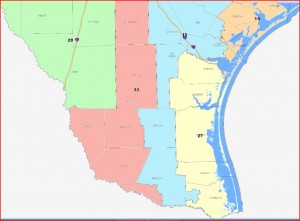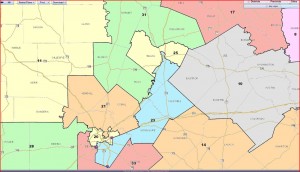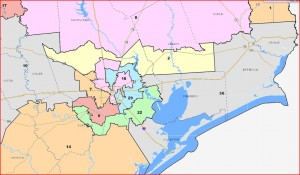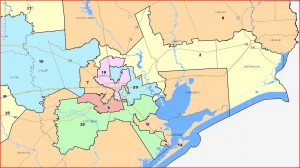We didn’t get a Congressional map from the Senate Redistricting Committee, though we may now get one in a special session but that didn’t stop State Rep. Marc Veasey from drawing his own before sine die.
In Veasey’s map, thirteen of the state’s 36 districts would be minority districts, all of which would lean Democrat, along with one in Travis County. The other 22 districts would lean Republican.
Veasey said he was using the “same logic” Republicans used in 2003 redistricting in arguing that 55 percent of the seats should favor Republicans because 55 percent of the state voted Republican at the time.
“A certain percentage of the population is African-American and Latino and a certain number of seats should be as well,” Veasey said.
Part of Veasey’s motivation in presenting his own map was to promote his approach to redistrict his home of southeast Fort Worth. The African-American community is still smarting from 2003 redistricting, when it was drawn into Denton County-based District 26, now held by U.S. Rep. Michael Burgess, R-Lewisville. In Veasey’s map, the community would be part of District 35, an African-American district which would also include southeast Arlington and southwest Dallas.
“I wanted to do this for folks in my district who felt they had been wronged last time,” Veasey said.
Veasey emphasized that his map still provides plenty of political opportunities for “the next young stable of leaders in the Republican Party” citing Anglo state representatives Kelly Hancock of Fort Worth, Ken Paxton of McKinney and Van Taylor of Plano.
“It doesn’t take away any opportunities from the Van Taylors and Kelly Hancocks or anyone like that who are future leaders in the Republican Party…Their communities that they represent still have more opportunities than Black and Latino,” Veasey said.
Of course, the Republicans drew a map that was intended to give them far more than 55% of the seats, but that’s neither here nor there. Veasey’s plan is Plan C121, so let’s look at some pictures.
According to Veasey’s press release, which is beneath the fold, CD34 is a “new, effective Latino Opportunity District” and CD35 is a “new, effective African American Opportunity District”. I would have to check to see if CD35 includes Rep. Veasey’s home precinct, but I’d be shocked if it didn’t.
CD33 is “a new, effective Latino Opportunity District in South Texas.” No room here for Aaron Pena, that’s for sure. The interesting thing is that CD33 continues up into Bexar County, where it takes over a lot of the turf currently in CD23. CD23 in turn gets shifted to the east, while CD28 takes over the western portion of what had been CD23. Here’s a look at the new CD23 and the districts around it:
CD23 would be the “new” Central Texas district in this plan; it would clearly lean Democratic, as would CD27 in South Texas. Veasey’s plan gets to 14 Democratic seats, which by the way is only 39% of 36 total seats and thus still quite reasonable for the Republicans even if you think 2010 was a normal year, by adding those two currently R-held seats to the three new Democratic ones. The district that really interests me in this map is CD31. There’s a piece of Bell County in that district that I can’t quantify, but here are the Sam Houston numbers for the other counties from 2008:
County Wainwright Houston ============================ Blanco 2,951 1,490 Burnet 10,764 4,903 Hays 26,845 26,389 Williamson 81,458 61,782 Total 122,018 94,564
That’s a 56% Republican district, with the population centers of Williamson and Hays trending blue. That would be a district to watch.
Finally, the new Republican district:
No new Latino district for Harris County, which as Greg notes stands in contrast to MALDEF’s vision. Basically, CD02 takes up more turf and shifts west. CD36 is an amalgam of territory from CDs 02, 08, 14, and 22 and would certainly be Republican. A piece of it is in Harris as well. CD10 becomes solid red as it sheds Travis County and becomes the fourth CD with a piece of Fort Bend. For comparison’s sake, here’s the same area as it is today:
While this is all mostly an academic exercise, as Veasey’s map is hardly likely to get debated, there is a reason for this beyond showing what could be, and that’s showing a court what could be.
Sen. Kel Seliger said his redistricting committee ran out of time, but did produce a map that a federal judge could consider. The committee has not made the map public, and Seliger would not characterize what his map would do in terms of ethnic representation.
“We will take our product … and ask our state officers to present this product to the court as our answer to the legal proceeding,” Seliger said. The court “will get dozens and dozens of them and ours will be a good deal more credible than almost all of them.”
Fort Worth Rep. Marc Veasey, a Democrat on the House redistricting committee, also produced a map that will go before the court. He says his would create two Hispanic-opportunity districts and one African-American district.
“The dramatic growth of the Latino and African American population is the only reason Texas is receiving additional congressional seats, and any plan that fails to add at least three additional effective minority opportunity districts would violate the Voting Rights Act,” Veasey said.
The Mexican-American Legal Defense Fund also proposed an alternative map that produced two Hispanic opportunity districts, one along the border and the other in the Dallas-Fort Worth area.
Perhaps that mystery map is the one that he and Rep. Burt Solomons now claim to have agreed on. Why they couldn’t get it out in time remains a mystery, but whatever. As for MALDEF, they will argue for their map in court as well. We’ll just see how it plays out from here.
Rep. Marc Veasey Offers “Fair Texas” Congressional Plan
Proposed Map Establishes Benchmark for Fair and Legal Representation Under the Voting Rights ActAustin – Today, due to the lack of legislative action on congressional redistricting, State Representative Marc Veasey (D-Ft. Worth) offered the “Fair Texas Plan” for Texas Congressional Districts. The Fair Texas Plan provides representation that is required by the Voting Rights Act in light of the fact that Latinos and African Americans population growth is responsible for Texas receiving four additional congressional districts following the 2010 census.
“The Fair Texas Plan demonstrates that it is possible to draw a plan that meets the legal requirements of the Voting Rights Act and restores racial and partisan balance and fairness to the Texas congressional delegation,” Veasey said.
The Fair Texas Plan creates three additional effective minority opportunity districts that have a majority minority Citizen Voting Age Population (CVAP), and could accommodate a fourth.
Ø District 33 is a new, effective Latino Opportunity District in South Texas.
Ø District 34 is a new, effective Latino Opportunity District in the DFW area.
Ø District 35 is a new, effective African American Opportunity District in the DFW area.
Ø District 36 in the proposed plan is a new Republican-leaning Southeast Texas district.“The dramatic growth of the Latino and African American population is the only reason Texas is receiving additional congressional seats, and any plan that fails to add at least three additional effective minority opportunity districts would violate the Voting Rights Act,” Veasey said.
Veasey said the current congressional districts were the result of a 2003 partisan gerrymander that was achieved by systematically packing and splitting minority communities, noting that its impact was especially harmful in North Texas. Almost 1.4 million Latinos in Dallas and Tarrant Counties are placed in six different congressional districts and Veasey’s Tarrant County community is the largest African American community in the country without a voice in Congress.
“The Fair Texas Plan creates two additional effective minority opportunity districts in the Dallas-Ft. Worth area and preserves the existing Dallas-based District 30, which is currently represented by Congresswoman Eddie Bernice Johnson, who supports the plan,” Veasey said.
State Representative Roberto Alonzo (D-Dallas) offered his support for the plan in the Dallas-Fort Worth area, adding, “The tremendous growth in Hispanic numbers in the state should demand nothing less than what is rightfully deserved and, frankly, has been a long time coming. Anything less than two new Latino majority congressional districts – and especially one for the DFW/North Texas region – would fail to account for the remarkable demographic shift that began over twenty years ago.”
“We will not allow another gerrymander to be drawn that seeks to shuttle us off to a basement where we would be invisible for the next ten years. The Fair Texas Plan gives all Texans an opportunity to have their voices heard in Congress,” Veasey concluded.






We didn’t get a Congressional map from the Senate Redistricting Committee …
Kuff–I state without proof that they clearly waited for you to type that sentence and then released their map.
http://gis1.tlc.state.tx.us/download/Congress/PLANC125.pdf
http://gregsopinion.com/?p=11831
http://www.dailykos.com/story/2011/05/31/980877/-The-Official-Texas-Map
These are the hazards of relying on WordPress’ “schedule” function. I wrote this post on Friday, figuring I’d need something splashy for the first day post-sine die. The best laid plans and all that. I’ll have a post on the Seliger-Solomons map in the morning.
Pingback: Plans from an alternate universe: The Veasey-West plan – Off the Kuff
Pingback: Veasey joins in redistricting litigation – Off the Kuff